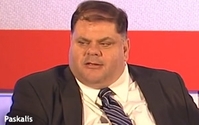
Marketers should not think of mobile as a mere media channel, but as the key to the “human operating system” because people are perpetually connected to their devices. “Until we
realize this is the gateway to the consumer mind, I think we’re going to be pushing a rock up a hill.”
That was the
advice of Lou Paskalis, SVP, enterprise marketing and media, Bank of America, speaking at the Interactive Advertising Bureau’s annual mobile conference Monday. While he may have been engaging in
a bit of hyperbole, his broader message was that mobile advertising in particular must be relevant and engaging in order to succeed.
Despite all the talk about a mobile-first mindset the last few years, he said mobile often is still simply bolted on to broader campaigns rather than being a core
focus for agencies and advertisers. Too frequently, they are caught in a vicious cycle of pointing to oft-cited limitations of mobile like the impact of screen size on ad creative and the lack of
standard metrics to push for higher-quality work.
advertisement
advertisement
To break that pattern, he suggested that agencies and their clients think
like marketers rather than advertisers. “Mobile is a marketing platform. Marketers start with consumer insights -- they relish need states, and tailor programs to those need states and develop
pathways to put them in front of consumers” in useful, timely ways.
In that
vein, Paskalis also said companies should think of building relationships first and foremost via mobile rather than generating transactions. He cited Starbucks as an example of a company following
this principle with the integration of its loyalty program and mobile tools. Paskalis also urged the packed room to take risks in mobile and not wait for other companies to lead the way.
“We have to be comfortable with the concept of failure. And fail fast, and learn from it,” he said.
Among BofA’s
own mobile efforts, Paskalis cited BofA’s much-publicized “Face Retirement” campaign launched in 2012 for Merrill Edge that allowed people to see what they would look like at their
retirement age. Earlier this year, the banking giant released a mobile app using 3D animation to show the aging process and provide information about retirement investing.
However, he conceded that the longer lead time needed for building high-impact mobile campaigns and tools remains a challenge. A key is accelerating collaboration of the
media and creative sides to speed up the process. “You’ve got to take yourself into those conversations…help drive that closure, otherwise you get lost in building a mobile
experience,” he said.
During the Q&A session, he said mobile is about 15% of “a lot of people’s jobs,” and 100% of one person’s
job. “What we need to do is figure out either a migratory path or blur the lines a little bit. Some of the digital baggage works well in mobile, and a lot of it doesn’t,” he said. He
added that insights about consumer habits should determine what works better in mobile than online.
And while mocking the
mobile banner ad during his presentation, Paskalis conceded that BofA has done its part to contribute to the profusion of the format. “A lot of my banners are up in this mess, too,” he
said, referring to a slide showing a mass of the much-maligned sliver ads that appear on smartphone screens.